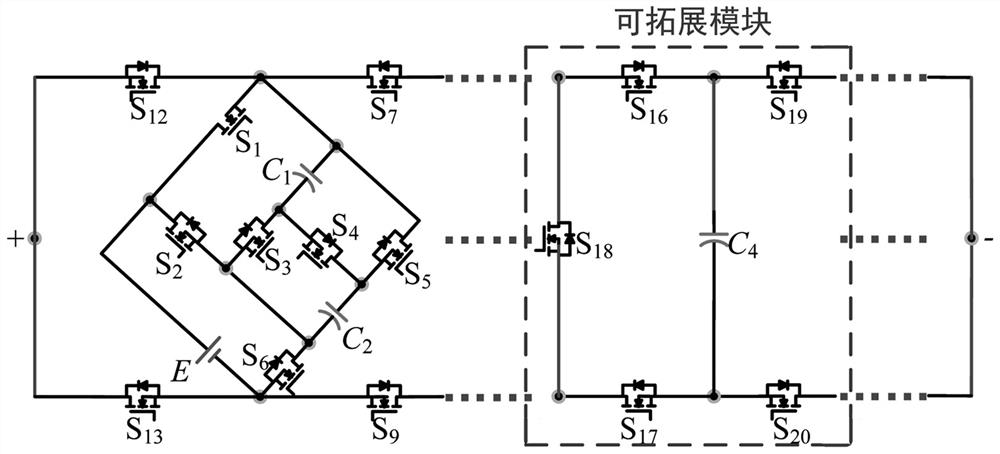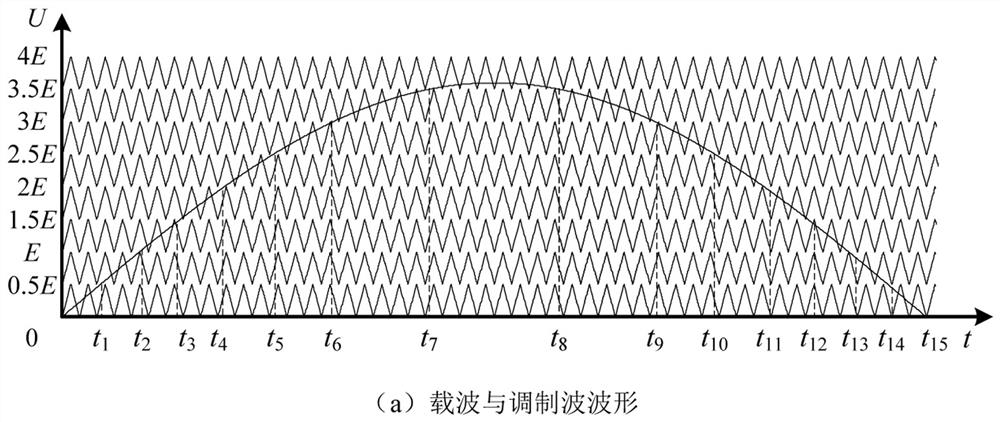A high-gain low-stress photovoltaic multi-level inverter and control method
A multi-level inverter, low-stress technology, applied in photovoltaic power generation, electrical components, conversion of AC power input to DC power output, etc., can solve the problem of maximum power point voltage reduction, DC capacitor voltage equalization, and photovoltaic power generation units The output voltage cannot meet the grid-connected requirements, etc., so as to reduce the control complexity and improve the output level
- Summary
- Abstract
- Description
- Claims
- Application Information
AI Technical Summary
Problems solved by technology
Method used
Image
Examples
Embodiment 1
[0053] like figure 1 As shown, a high-gain low-stress photovoltaic multi-level inverter includes a boost unit, an I-shaped switch structure, and an independent capacitor C 3 and two half-bridge structures; the inverter in this embodiment consists of a boost unit and an independent capacitor C 3 It is formed by connecting an I-shaped switch structure, and uses two half-bridge structures instead of H-bridges to switch the polarity of the output level.
[0054] The boosting unit includes a photovoltaic DC power supply E, an electrolytic capacitor C 1 , Electrolytic capacitor C 2 , switch tube S 2 , switch tube S 3 , switch tube S 4 , switch tube S 5 , switch tube S 6 and switch S without reverse diode 1 ; the switch tube S 1 The input end and the switch tube S 2 The input end of the photovoltaic DC power supply E is connected to the positive pole; the switch tube S 1 The output terminal with electrolytic capacitor C 1 anode, switch tube S 5 connected to the input end...
Embodiment 2
[0065] like figure 2 As shown, this embodiment provides an expandable high-gain low-stress photovoltaic multi-level inverter, including the high-gain low-stress photovoltaic multi-level inverter described in Embodiment 1 and an expandable module;
[0066]The expandable module includes a switch tube S 16 , switch tube S 17 , switch tube S 18 , switch tube S 19 , switch tube S 20 and electrolytic capacitor C 4 ; the switch tube S 16 The input end and the switch tube S 19 input terminal, electrolytic capacitor C 4 The anode is connected; the switch tube S 16 The output end and the switch tube S 18 connected to the input end; the switch tube S 17 The input end and the switch tube S 18 connected to the output end; the switch tube S 17 The output end and the switch tube S 20 , the electrolytic capacitor C 4 connected to the cathode.
[0067] The boost unit charges all the expandable modules at the same time, and each module can be discharged in series with the boost ...
Embodiment 3
[0069] This embodiment provides a control method for a high-gain and low-stress photovoltaic multi-level inverter:
[0070] A drive signal is generated, and the high-gain low-stress photovoltaic multi-level inverter described in Embodiment 1 is controlled by the drive signal to work in 17 working states and output 17 levels, and the high-gain low-stress photovoltaic multi-level inverter The level inverter outputs 4 times the voltage gain.
[0071] Specifically, as shown in Fig. 3(a)-3(d), the modulation principle is shown in Fig. 3(a)-3(d), the carrier stacking pulse width modulation technology is used, and 16 triangular carriers with the same amplitude and the same frequency are stacked in sequence, and a sine modulated wave is used. After comparison, the obtained 16-channel original pulse waveforms are logically combined to obtain the gate pulse drive signal used to drive the switch tube on and off. The inverter has a large number of output levels, and the principle of the ...
PUM
 Login to View More
Login to View More Abstract
Description
Claims
Application Information
 Login to View More
Login to View More - R&D
- Intellectual Property
- Life Sciences
- Materials
- Tech Scout
- Unparalleled Data Quality
- Higher Quality Content
- 60% Fewer Hallucinations
Browse by: Latest US Patents, China's latest patents, Technical Efficacy Thesaurus, Application Domain, Technology Topic, Popular Technical Reports.
© 2025 PatSnap. All rights reserved.Legal|Privacy policy|Modern Slavery Act Transparency Statement|Sitemap|About US| Contact US: help@patsnap.com



